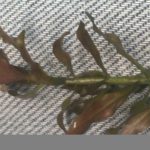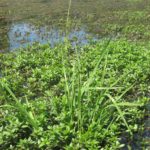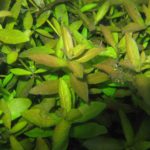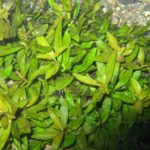Hygrophila polysperma
Non-Native
- Hygro enmass with Wild Rice
- Hygro submersed
USDA, NRCS. 2018. The PLANTS Database (http://plants.usda.gov, 28 March 2018). National Plant Data Team, Greensboro, NC 27401-4901 USA.
Illustration courtesy of University of Florida/IFAS Center for Aquatic and Invasive Plants. Used with permission.
What is Hygro, Miramar Weed, or East Indian Hygrophila?
Physical Characteristics
Leaves:
- Sword-shaped
- Simple
- 2-5 inches long
- 0.2-1 inches wide
Flowers:
- Immobile
- Clustered at axils
- Straight bracts
- 5 sepals, sword-shaped, about 0.196 inches long
- White along the edges
- Covered with long, soft hairs
- Yellow petals
- Upper lip has 2 teeth about 0.098 inches long
- Lower lip is 3-lobed
- 4 stamen
Fruit:
- Long and thin
- 0.31-0.5 inches long
- Holds 16 to 18 seeds
- Smooth
- Hairless
Stem:
- Rectangular
- Branching
Hygrophila can be confused with the native water primrose (submerged type), but water primrose does not have the fingerlike projections at the base of the leaves nor the squarish stem. Hygrophila can be completely submerged or stand above the water like an emergent plant.
Where Does it Grow?
EDDMapS. 2024. Early Detection & Distribution Mapping System. The University of Georgia – Center for Invasive Species and Ecosystem Health. Available online at http://www.eddmaps.org/; last accessed January 28, 2024.
Non-Native
Hygrophila is a perennial plant. It is native to India and Malaysia and was probably brought to the U.S. for the aquarium industry.
Hygrophila can be found in marshy areas along streams, swamps, or on shores of ponds where its horizontal roots form colonies.
Is it Invasive?
Hygrophila is considered a noxious pest because it grows so rapidly, out competing and eliminating native species.
This plant is not native to North America and should not be introduced into new water bodies and should be treated with herbicide when present.






